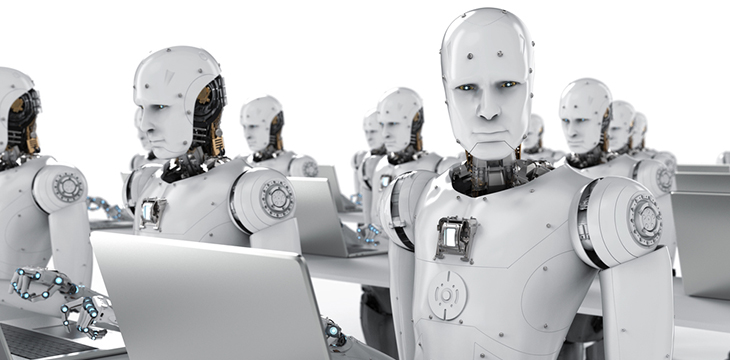|
Getting your Trinity Audio player ready...
|
India has attributed the biggest disruption in the future of work to the accelerated growth in artificial intelligence (AI), according to the country’s Economic Survey, a document that looks at trends in the country and helps establish resource allocation in the budget. This year’s document was released on July 22, a day before India’s Union Budget announcement, an annual financial statement that identifies planned government spending and expected revenue and expenditures for a specific financial year.
Economic Survey 2023-24 was presented in the Parliament by India’s Finance Minister Nirmala Sitharaman.
India, with its vast demographic dividend and a young population, is uniquely situated as AI poses both risk and opportunity, the Economic Survey said. A particular risk is the BPO (business process outsourcing) sector, where GenAI is revolutionizing the performance of routine cognitive tasks through chatbots, and employment in the sector is estimated to decline considerably in the next ten years. In the following decade, however, the gradual diffusion of AI is expected to augment productivity.
“Information technology and business services will likely retain their prominent international presence in the medium term. However, studies suggest that the application of artificial intelligence (AI) is likely to restrain the growth opportunities for business services progressively and, therefore, poses a challenge to long-term sustainability and job creation. Thus, focusing on human capital to take advantage of the agglomeration effects of large, well-functioning cities is critical for the growth of services, especially those with global market potential,” the Economic Survey said.
The Economic Survey said India’s corporate sector’s profitability was at a 15-year high in FY24, with profits quadrupling between FY20 and FY23. However, it said that businesses have an obligation to themselves to strike the right balance between capital deployment and labour deployment. In their fascination with AI and fear of erosion of competitiveness, businesses have to bear in mind their responsibility for employment generation and the consequent impact on social stability.
The Economic Survey noted that given the Indian population’s affinity for working with technology, as seen with the digital public infrastructure, proactive interventions by the government and industry can position the country as a key player in the AI age.
In March, India approved $1.24 billion for the next five years, a significant move to strengthen the AI ecosystem. The government has also introduced initiatives to ensure an AI-enabled ecosystem and to connect AI to the youth of the country. These include ‘Future Skills Prime,’ ‘YUVAi: Youth for Unnati and Vikas with AI’, a national program for school students, and ‘Responsible AI for Youth 2022’.
Growth of global capability centers, tech startups
According to the Economic Survey, the growth of IT services has also supported the expansion of Global Capability Centers (GCCs) and the tech start-up ecosystem in India. GCCs are usually part of bigger corporations that provide various services, including research and development, IT services, and business process outsourcing.
GCCs in India have grown significantly to more than 2,740 units by FY23 from over 1,000 centers in FY15. These centers contribute to economic growth by providing high-quality employment. Revenue from India’s GCCs increased to $46 billion in FY23 from $19.4 billion in FY15, growing at a compound annual growth rate (CAGR) of 11.4%.
Technology startups in India have also grown remarkably to approximately 31,000 in 2023 from around 2,000 in 2014. According to NASSCOM, a trade association of India’s IT industry, the sector witnessed the creation of about 1000 new tech start-ups in 2023.
“Several factors have contributed to the rise of start-ups in various sectors. Changes in consumption patterns and increased internet penetration paved the way for retail tech startups. The BFSI sector [Banking, Financial Services and Insurance] saw a surge in start-ups starting in 2016, driven by significant events such as the introduction of Unified Payments Interface (UPI). The demand for scalable and efficient cloud solutions led to the growth of Software as a Service (SaaS) start-ups, resulting in 21 unicorns since 2014,” the Economic Survey noted.
Moreover, according to NASSCOM, India’s tech startup ecosystem ranks third globally and has performed considerably better than the U.S. and the U.K.
Internet subscribers in India jumped to 95.4 crore (954 million) in March 2024 from 25.1 crore (251 million) in March 2014, of whom 91.4 crore (914 million) access the internet via wireless phones. The internet density also increased to 68.2% in March 2024. The cost of data has declined substantially in India, significantly improving the average wireless data usage per subscriber.
The Indian e-commerce industry is expected to cross $350 billion by 2030, the Economic Survey said. India’s e-commerce market has gained significant momentum during the past few years owing to technological advancements and evolving new-age business models coupled with government initiatives, including the Digital India program and UPI. However, data privacy issues and increasing online fraud have turned out to be the most significant hurdle in the growth of e-commerce in India.
In order for artificial intelligence (AI) to work right within the law and thrive in the face of growing challenges, it needs to integrate an enterprise blockchain system that ensures data input quality and ownership—allowing it to keep data safe while also guaranteeing the immutability of data. Check out CoinGeek’s coverage on this emerging tech to learn more why Enterprise blockchain will be the backbone of AI.
Watch: Understanding the dynamics of blockchain & AI

 01-06-2026
01-06-2026 




